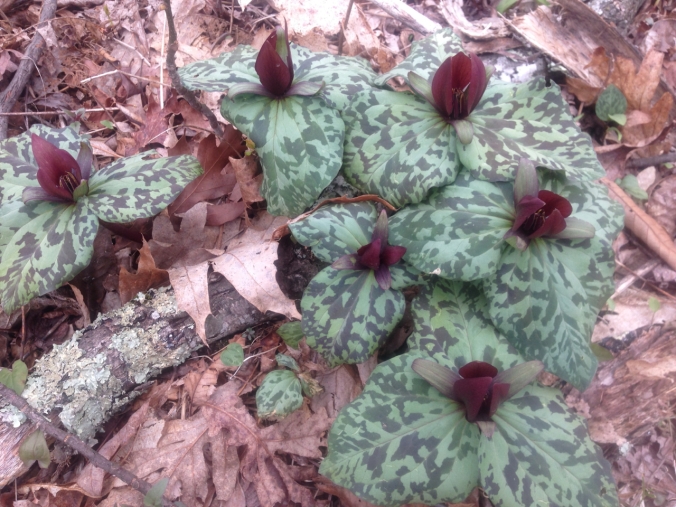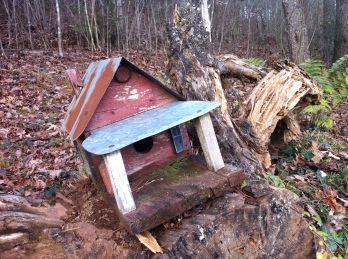This essay was first published in The Crazy Wisdom Community Journal: Issue #60, May through August 2015. The online version in the Journal can be found here.
There are three ponds on my in-laws’ property in northern Georgia. Each was stocked decades ago with largemouth bass and bluegill, and since then, the fish populations have flourished. I’ve seen them from the water’s edge, sleek shapes among the weeds, under overhanging branches, and near the pilings of the old dock. On a recent visit, my kids asked if we could go fishing, so we went to the nearest of the ponds with the two decrepit fishing rods from the wrap-around porch, rigged with the only two lures available. One rod sometimes loses its upper half with a hard cast. The other has a broken reel mount, so the reel is always on the brink of falling off.
I demonstrated how to cast and reel in the line, and the kids practiced casting toward the center of the pond. At first, they were too quick and jerky in their movements, naturally thinking that casting far requires a lot of force, and the lures flew astray or splashed hard into the water just a few feet away. “Try slowing down and moving more smoothly,” I told them, “and let the rod do the rest.” After some more fits and starts, they sent their lures soaring gracefully farther and farther toward the middle of the pond as their fishing rods became extensions of their arms. Their smiles flashed as they hit their marks more often than not. I showed them how to work the lures back to shore, varying speeds and angles and bringing them close past likely fish hideouts.
As I watched the children, memories of my grandfather rushed into my mind. Papa was an angler, not by profession, but by passion. A Chicago native, he fished the lakes of the Midwest for years, returning to his favorites, like Lake of the Woods in Minnesota, time and again. Later, when he and Nana moved to my hometown of Los Angeles, he didn’t get to fish as often. Yet he talked about fishing with a wistfulness that I didn’t hear from him on any other subject, though baseball sometimes came close for the former second baseman. When he talked fishing, his clear blue eyes shone and a grin lit his round face. His tackle box was among my favorite things, a massive green case that opened by splitting apart the top to reveal six stacked trays, three on a side, which lifted into perfect tiers to reveal a meticulously organized array of lures.
When I was about ten years old, Papa bought me my first fishing gear, a grey, six-foot, light-action Browning rod and matching Mitchell reel. That same evening, I took the rubber band off the spool of the reel – exactly what he had told me not to do. I did it so I could see the line, thin and bluish-white, almost luminous in the light of my bedroom. The line instantly sprang from the spool with a will and quickly grew into a bird’s nest, even as I tried to hold it in place.
I shuffled down the hall and into the dining room, where Papa was sitting at the table, and handed him the mess. He took a slow, appraising look and said, “Took off the rubber band, huh?” Then he set to work on it. His hands were knobby and his fingers blunt, perhaps from the physical labor he did as a grocery warehouseman, yet he deftly handled the ultra-fine line. He could have cut it, of course. Or he could have made me deal with it to teach me a lesson. But he knew that the lesson had been learned already. Nothing more needed to be said.
Fishing with my children, I remembered standing as a boy with Papa in my front yard, casting a rubber weight over and over again as he gently gave me nuggets of advice. I remembered my practice casts hitting the near edge of the neighbor’s lawn, then the middle, and eventually the driveway, beyond the lawn, and Papa giving me encouragement: “Oooh! That was a good one! Try putting the next one over there.”
Before long, Papa took me to Lake Casitas for my first real fishing trip. There, he showed my cousin and me how to place our casts precisely under overhangs, where bass might be lurking, though only my uncle caught anything on that broiling day. Later, my cousin and I attended a day camp that ended the summer with a week-long fishing adventure in the Sierras. Before that trip, Papa showed us how to rig for rainbow and brown trout. Fishing the San Joaquin and Owens Rivers, Twin Lakes, Horseshoe Lake, and Lake Mary, I did as he taught, keeping quiet by the bank, standing so that my shadow did not darken the water, and placing my bait or lures right where I wanted them. He was a great teacher; I caught plenty of fish.
Despite my childhood love of fishing, and the fact that Papa frequently extolled the angling wonders of Michigan when I moved here 20 years ago, as an adult I’ve fished very little. Yet in Georgia, as I taught my children, Papa’s lessons came back to me as if riding into my mind on my memories of him. When my kids felt comfortable casting and working the lures back to shore, we talked about where the fish might be, and I taught them as Papa had taught me. There were some good looking overhangs and weedy areas, and while we risked losing our lures to snags, the kids felt confident that they could place them right where they wanted them, just as my cousin and I had at Lake Casitas and in the Sierras so many years before. That’s what they did, and it worked. Each of them caught and released a lot of fish.
They caught the fishing bug, too, as I had once. During our few days in Georgia, the children and I grabbed whatever time we could to go down to the pond and see if the fish were biting. The children’s eyes shone, and their faces wore joyous grins, as Papa’s had when he fished or just talked about it. I watched quietly as the children angled, admiring their patience and concentration. Their casts were beautiful – their arms cocked back and then brought their fishing rods forward swiftly and smoothly, and their lures flew into the pond trailed by an arc of line that settled gently onto the water. I watched their intent looks as they worked the lures back to shore, bringing them right past where they thought the fish might be waiting. And I thought about how much Papa would have loved that moment. The surge of closeness to him that I felt watching his great-grandchildren fish that pond in northern Georgia brought to the surface not only how much I miss him but also the tremendous gifts he gave me over the years: his love, encouragement, and knowledge. They are gifts I try to pass along to my children, and like most parents, I don’t always succeed. But when I do, my mind fills with warm thoughts of those who bestowed those gifts upon me, and Papa was one of my primary sources.


